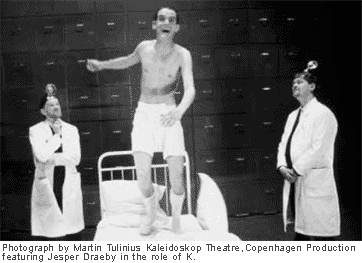
 | |
 |
|
by MARTIN TULINIUS Set Designer K. takes its starting point from the figure of the modern man: the author Franz Kafka. The play is a compression of the life of this fragile human being whose writing has continued to fascinate us. The play focuses on this mystical and guilt ridden person and on the eternal conflicts in his poetry, which mirror our own dilemmas today. These conflicts are expressed in the complex personality of K and are important aspects of the narrative within this drama. K. encourages us to reflect on our own feelings toward the human being, society, and this archetypal character in his eternal search for a meaning to life. In this way the drama is highly relevant to our present times. The life and poetry of Kafka inform the setting for this narrative. K. updates Kafka’s universe and puts it into a modern context with the use of video, slides, and computer graphics. The visual concept of the play, with its use of visual art technology as a theatrical agent in telling the story, challenges the traditional separation of visual art, technology, and live performance. It does so not because this approach is trendy or popular, but because it mirrors realities of the present age – the third industrial revolution. This new world, the computer age of synthetic reality, juxtaposes efficiency, knowledge, and global communication on the one hand with paternalism, alienation, and loneliness on the other. The scenography of the play visually evokes the psychological dilemmas that Kafka experienced. | The direction and the visual design combine two distinct traditions within Western theatre: text-based theatre and aesthetically driven performance. From the outset, it has been my intention to create a show that would bridge these traditions, presenting the dramatised text in an aesthetic, metaphorical, and modern framework in which audio/visual methods are used to amplify and magnify the story and in this way have a stronger emotional impact on the audience. Pictures, symbolic gestures and choreography are important players in the narration of the piece. The use of wordless scenes is important in creating the dreamlike atmosphere that is often found in the writing of Kafka. In many ways these scenes have latent meaning in the dramaturgic structure. It may be plausible to claim that the unspoken, audio/visual elements in the piece are more Kafkaesque than the spoken. |
 |
|
 |
| ++ HOME | ++ PORTFOLIO | ++ CREDITS | ++ TICKETS | |||